What is a Human Factors Engineer or Ergonomist?
Position Description Design objects, facilities, and environments to optimize human well-being and overall system performance, applying theory, principles, and data regarding the relationship between humans and respective technology. Investigate and analyze characteristics of human behavior and performance as it relates to the use of technology.
What Do Human Factors Engineers and Ergonomists Do On a Daily Basis?
- Apply modeling or quantitative analysis to forecast events, such as human decisions or behaviors, the structure or processes of organizations, or the attitudes or actions of human groups.
- Develop or implement human performance research, investigation, or analysis protocols.
- Design cognitive aids, such as procedural storyboards or decision support systems.
- Collect data through direct observation of work activities or witnessing the conduct of tests.
- Conduct research to evaluate potential solutions related to changes in equipment design, procedures, manpower, personnel, or training.
- Review health, safety, accident, or worker compensation records to evaluate safety program effectiveness or to identify jobs with high incidence of injury.
Skills Needed to be a Human Factors Engineer or Ergonomist
Below is a list of the skills most Human Factors Engineers and Ergonomists say are important on the job.
Critical Thinking: Using logic and reasoning to identify the strengths and weaknesses of alternative solutions, conclusions or approaches to problems.
Complex Problem Solving: Identifying complex problems and reviewing related information to develop and evaluate options and implement solutions.
Active Listening: Giving full attention to what other people are saying, taking time to understand the points being made, asking questions as appropriate, and not interrupting at inappropriate times.
Speaking: Talking to others to convey information effectively.
Reading Comprehension: Understanding written sentences and paragraphs in work related documents.
Writing: Communicating effectively in writing as appropriate for the needs of the audience.
Types of Human Factors Engineer or Ergonomist
- Human Factors Specialist
- President Ergonomic Consulting
- Principal Engineer
- Human Factors Engineer
- Human Factors Ergonomist
Is There Job Demand for Human Factors Engineers and Ergonomists?
In 2016, there was an estimated number of 257,900 jobs in the United States for Human Factors Engineer or Ergonomist. New jobs are being produced at a rate of 9.7% which is above the national average. The Bureau of Labor Statistics predicts 25,100 new jobs for Human Factors Engineer or Ergonomist by 2026. There will be an estimated 19,700 positions for Human Factors Engineer or Ergonomist per year.
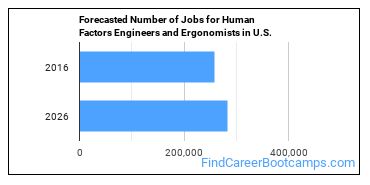
The states with the most job growth for Human Factors Engineer or Ergonomist are Nevada, Utah, and Alabama. Watch out if you plan on working in New Mexico, Vermont, or Maryland. These states have the worst job growth for this type of profession.
Salary for a Human Factors Engineer or Ergonomist
The salary for Human Factors Engineers and Ergonomists ranges between about $56,470 and $132,340 a year.
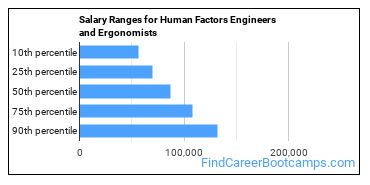
Human Factors Engineers and Ergonomists who work in Wyoming, Washington, or Texas, make the highest salaries.
How much do Human Factors Engineers and Ergonomists make in different U.S. states?
| State | Annual Mean Salary |
|---|---|
| Alabama | $87,870 |
| Arizona | $95,940 |
| Arkansas | $77,100 |
| California | $107,810 |
| Colorado | $100,460 |
| Connecticut | $89,830 |
| Delaware | $94,590 |
| District of Columbia | $88,380 |
| Florida | $77,410 |
| Georgia | $86,220 |
| Hawaii | $95,590 |
| Idaho | $94,830 |
| Illinois | $88,850 |
| Indiana | $74,430 |
| Iowa | $82,770 |
| Kansas | $79,580 |
| Kentucky | $79,170 |
| Louisiana | $99,090 |
| Maine | $88,020 |
| Maryland | $102,200 |
| Massachusetts | $102,210 |
| Michigan | $89,330 |
| Minnesota | $90,580 |
| Mississippi | $82,040 |
| Missouri | $87,620 |
| Montana | $100,640 |
| Nebraska | $85,950 |
| Nevada | $87,140 |
| New Hampshire | $91,530 |
| New Jersey | $98,050 |
| New Mexico | $102,120 |
| New York | $94,700 |
| North Carolina | $87,110 |
| North Dakota | $79,980 |
| Ohio | $84,060 |
| Oklahoma | $85,280 |
| Oregon | $90,980 |
| Pennsylvania | $86,080 |
| Rhode Island | $97,610 |
| South Carolina | $87,080 |
| South Dakota | $82,780 |
| Tennessee | $84,070 |
| Texas | $109,880 |
| Utah | $89,830 |
| Vermont | $79,700 |
| Virginia | $93,980 |
| Washington | $106,980 |
| West Virginia | $94,480 |
| Wisconsin | $77,260 |
| Wyoming | $102,730 |
What Tools do Human Factors Engineers and Ergonomists Use?
Although they’re not necessarily needed for all jobs, the following technologies are used by many Human Factors Engineers and Ergonomists:
- Microsoft Excel
- Microsoft Word
- Microsoft Office
- Hypertext markup language HTML
- JavaScript
- Microsoft PowerPoint
- jQuery
- Microsoft Visio
- Adobe Systems Adobe Photoshop
- The MathWorks MATLAB
- SAS
- Microsoft Visual Basic
- Adobe Systems Adobe Illustrator
- IBM SPSS Statistics
- Computer aided design CAD software
- National Instruments LabVIEW
- Microsoft Internet Explorer
- Adobe Systems Adobe Dreamweaver
- Dassault Systemes CATIA
- Adobe Systems Adobe Flash
Becoming a Human Factors Engineer or Ergonomist
What education is needed to be a Human Factors Engineer or Ergonomist?
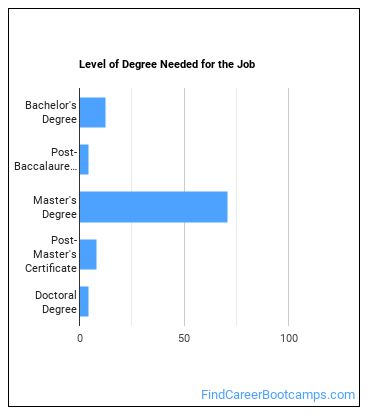
What work experience do I need to become a Human Factors Engineer or Ergonomist?
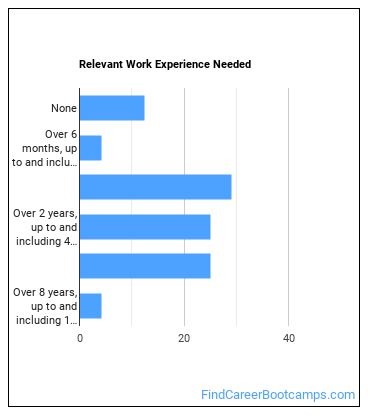
Who Employs Human Factors Engineers and Ergonomists?
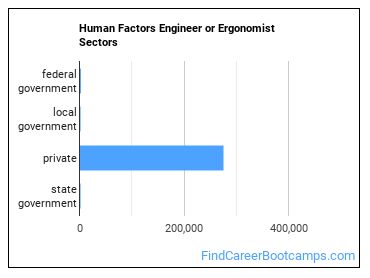
The table below shows the approximate number of Human Factors Engineers and Ergonomists employed by various industries.
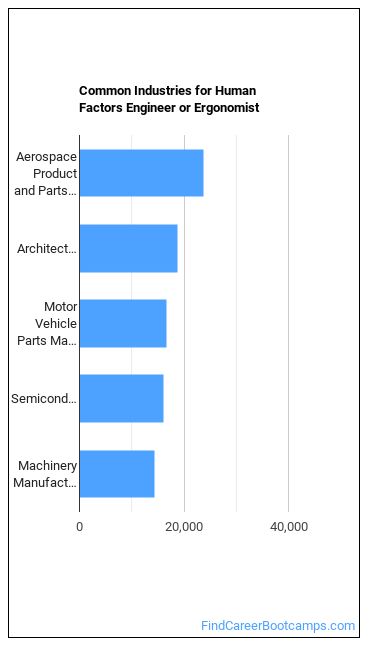
References:
Image Credit: {} via CC0 Public Domain
More about our data sources and methodologies.
